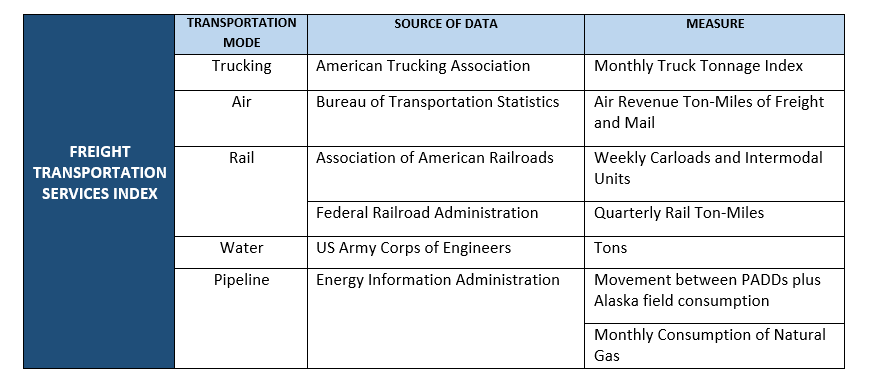Learn about the Freight TSI, one of the three components of the Transportation Services Index
Economic Indicators are essential for understanding, analyzing and predicting trends that come and go in an economy and maintaining a healthy, functional system. Since freight transportation is a vital component of supply chains and resultantly, the economy of the US, there are several indices designed by the government to examine the trends affecting the country.
The important indices are the Bureau of Transportation Statistics' Transportation Services Index, the Dow Jones Transportation Average (Dow Transportation Index), and Cass Information Systems' Cass Freight Index. These indicators reflect the responses of transportation service providers to the economy's demands for moving freight in the supply chain networks.
We shall discuss the Transportation Services Index and a significant series within it for the supply chain system in the US - the Freight Transportation Services Index
Transportation Services Index (TSI)
TSI is the Bureau of Transportation Statistics' premier index for measuring the domestic volume of freight and passengers moved, i.e. the volume of services performed by the indigenous for-hire transportation sector. It is a macro-level index published every month with data for a given month released two months later. The index shows how transportation services have increased or decreased on a monthly basis and helps to understand the present and future course of the economy with regard to for-hire transportation services. TSI also assists in analyzing short-term trends and shifts in freight transportation services output. By its nature as a freight movement measurement index, TSI acts as a leading indicator for the overall economic performance of the US economy.
Bureau of Transportation Statistics (BTS) is a part of the US Department of Transportation (DOT) and is the "preeminent source of statistics on commercial aviation, multimodal freight activity, and transportation economics, and provides context to decision makers and the public for understanding statistics on transportation. BTS promotes innovative methods of data collection, analysis, visualization, and dissemination to improve operational efficiency, to examine emerging topics, and to create relevant and timely information products that foster understanding of transportation and its transformational role in society."

Freight Transportation Services Index
Transportation Services Index has 3 series: Passenger TSI, Freight TSI, and Combined TSI. The data for each series is adjusted, weighed, and combined by BTS seasonally, because the input data for the index is highly influenced by the seasons and must reflect the trends accordingly. This data is weighed by the economic value of the for-hire transportation mode to the economy.
The Freight Transportation Index component of TSI consists of:
- For-hire trucking (excluding parcel services)
- Freight railroad services (including intermodal shipping)
- Inland waterway traffic
- Pipeline movements (including petroleum, petroleum products, and natural gas)
- Air freight
Since the TSI acts as a measure for freight volume in the US, it is highly sensitive to the economic trends and the general state of the economy. It has a positive relationship with consumer demand and spending - when the latter goes up, so does the index. When consumer demand is low and less amount of freight is being transported, the index numbers take a fall.
The basics of the Freight Transportation Services Index are:

Industries affected by Freight Transportation Services Index
IBISWorld has recognized the industries which are greatly affected by the Freight TSI. Among the industries listed, the biggest impact is felt by the following industries:
- Freight Forwarding Brokerages and Agencies in the US
- Aircraft Maintenance, Repair, and Overhaul in the US
- Freight Packing and Logistics Services in the US
- Local Freight Trucking in the US
- Transportation and Warehousing in the US
The Freight Transportation Services Index is the cornerstone of the Bureau of Transportation Statistics' analysis of the volume of freight movement in the country, as freight movement is both a gauge and a result of the economic condition of any nation. The index acts as a leading indicator of the overall economic performance of the United States and thus, is of profound importance to any freight broker or forwarder.